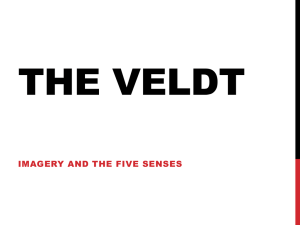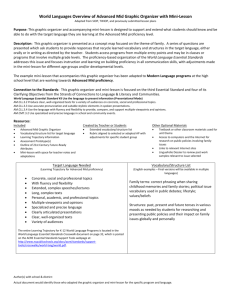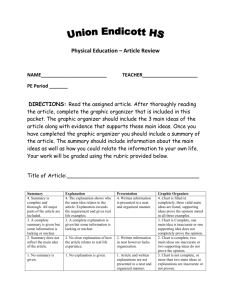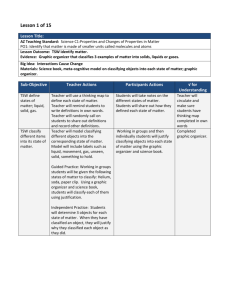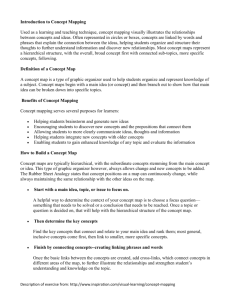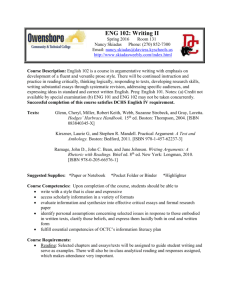SIOP LESSON PLAN
advertisement
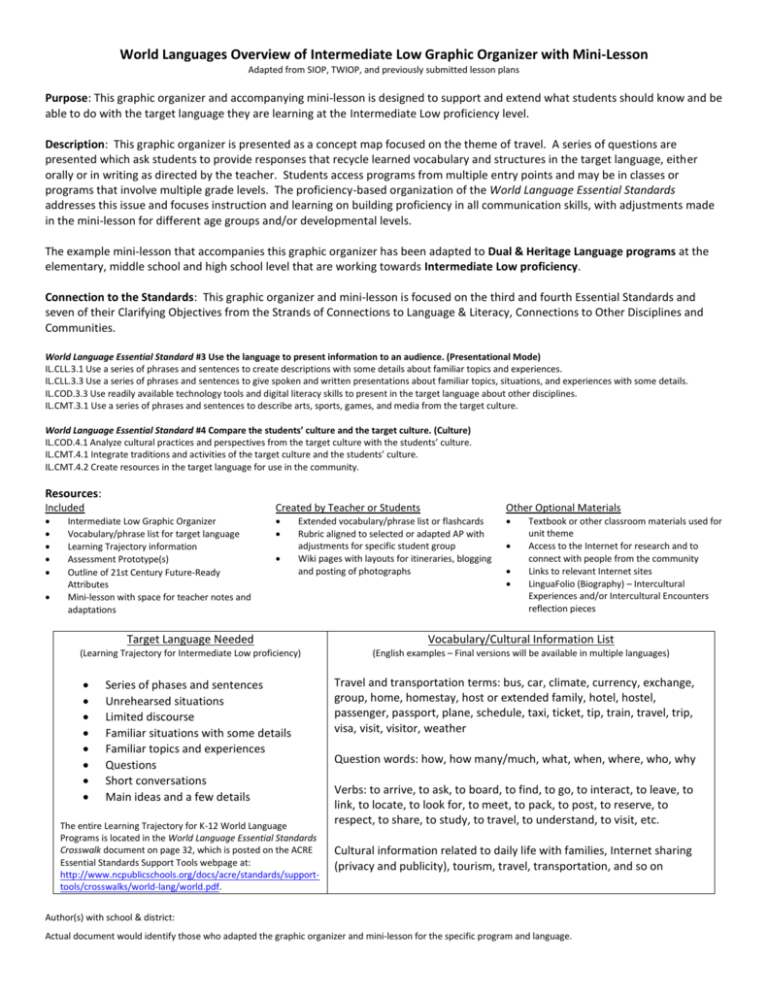
World Languages Overview of Intermediate Low Graphic Organizer with Mini-Lesson Adapted from SIOP, TWIOP, and previously submitted lesson plans Purpose: This graphic organizer and accompanying mini-lesson is designed to support and extend what students should know and be able to do with the target language they are learning at the Intermediate Low proficiency level. Description: This graphic organizer is presented as a concept map focused on the theme of travel. A series of questions are presented which ask students to provide responses that recycle learned vocabulary and structures in the target language, either orally or in writing as directed by the teacher. Students access programs from multiple entry points and may be in classes or programs that involve multiple grade levels. The proficiency-based organization of the World Language Essential Standards addresses this issue and focuses instruction and learning on building proficiency in all communication skills, with adjustments made in the mini-lesson for different age groups and/or developmental levels. The example mini-lesson that accompanies this graphic organizer has been adapted to Dual & Heritage Language programs at the elementary, middle school and high school level that are working towards Intermediate Low proficiency. Connection to the Standards: This graphic organizer and mini-lesson is focused on the third and fourth Essential Standards and seven of their Clarifying Objectives from the Strands of Connections to Language & Literacy, Connections to Other Disciplines and Communities. World Language Essential Standard #3 Use the language to present information to an audience. (Presentational Mode) IL.CLL.3.1 Use a series of phrases and sentences to create descriptions with some details about familiar topics and experiences. IL.CLL.3.3 Use a series of phrases and sentences to give spoken and written presentations about familiar topics, situations, and experiences with some details. IL.COD.3.3 Use readily available technology tools and digital literacy skills to present in the target language about other disciplines. IL.CMT.3.1 Use a series of phrases and sentences to describe arts, sports, games, and media from the target culture. World Language Essential Standard #4 Compare the students’ culture and the target culture. (Culture) IL.COD.4.1 Analyze cultural practices and perspectives from the target culture with the students’ culture. IL.CMT.4.1 Integrate traditions and activities of the target culture and the students’ culture. IL.CMT.4.2 Create resources in the target language for use in the community. Resources: Included Created by Teacher or Students Other Optional Materials Intermediate Low Graphic Organizer Vocabulary/phrase list for target language Learning Trajectory information Assessment Prototype(s) Outline of 21st Century Future-Ready Attributes Mini-lesson with space for teacher notes and adaptations Extended vocabulary/phrase list or flashcards Rubric aligned to selected or adapted AP with adjustments for specific student group Wiki pages with layouts for itineraries, blogging and posting of photographs Textbook or other classroom materials used for unit theme Access to the Internet for research and to connect with people from the community Links to relevant Internet sites LinguaFolio (Biography) – Intercultural Experiences and/or Intercultural Encounters reflection pieces Target Language Needed Vocabulary/Cultural Information List (Learning Trajectory for Intermediate Low proficiency) (English examples – Final versions will be available in multiple languages) Series of phases and sentences Unrehearsed situations Limited discourse Familiar situations with some details Familiar topics and experiences Questions Short conversations Main ideas and a few details The entire Learning Trajectory for K-12 World Language Programs is located in the World Language Essential Standards Crosswalk document on page 32, which is posted on the ACRE Essential Standards Support Tools webpage at: http://www.ncpublicschools.org/docs/acre/standards/supporttools/crosswalks/world-lang/world.pdf. Travel and transportation terms: bus, car, climate, currency, exchange, group, home, homestay, host or extended family, hotel, hostel, passenger, passport, plane, schedule, taxi, ticket, tip, train, travel, trip, visa, visit, visitor, weather Question words: how, how many/much, what, when, where, who, why Verbs: to arrive, to ask, to board, to find, to go, to interact, to leave, to link, to locate, to look for, to meet, to pack, to post, to reserve, to respect, to share, to study, to travel, to understand, to visit, etc. Cultural information related to daily life with families, Internet sharing (privacy and publicity), tourism, travel, transportation, and so on Author(s) with school & district: Actual document would identify those who adapted the graphic organizer and mini-lesson for the specific program and language. World Languages Overview of Intermediate Low Graphic Organizer with Mini-Lesson Adapted from SIOP, TWIOP, and previously submitted lesson plans Assessment Prototypes (APs) describing student product(s) Dual Language/Immersion for K-5 programs Dual Language/Immersion for 6-12 programs Students plan their class exchange trip to visit their exchange partners, which includes a homestay. The itinerary, travel experience, visits and interactions will be shared on a wiki so that the community can share in the adventure. Students plan their class study trip to visit their partner school, which includes a family homestay, hostel booking or dormitory living. The itinerary, travel experience, visits and interactions will be shared on a wiki so that the community can share in the adventure. Students plan their families’ visit to a home or heritage country, which includes staying with extended family or renting quarters in the community. The itinerary, travel experience, visits and interactions will be shared on a wiki so that the community can share in the adventure. Evaluate students’ wiki posts based on: descriptions of their personal and academic experiences, which should include details; evidence of reflection on what they have learned about interculturality and the perspectives and practices of another culture as compared to their own; inclusion of photos, links, videos, etc. to support and enhance their descriptions; and language used to express themselves to their community audience that is clear, concise, and accurate in regards to choices made about words, phrases, and tenses. Evaluate students’ wiki posts based on: descriptions of their personal experiences, which should include details; evidence of reflection on what they have learned about interculturality and the perspectives and practices of their home or heritage culture as compared to their own; inclusion of photos, links, videos, etc. to support and enhance their descriptions; and language used to express themselves to their community audience that is clear, concise, and accurate in regards to choices made about words, phrases, and tenses. Evaluate students’ wiki posts based on: descriptions of their experiences, which should include details; evidence of reflection on what they have learned about interculturality and the perspectives and practices of another culture as compared to their own; inclusion of photos, links, videos, etc. to support and enhance their descriptions; and language used to express themselves to their community audience that is clear, concise, and accurate in regards to choices made about words, phrases, and tenses. Heritage Language High School Credit programs 21st Century Future-Ready Attributes (See the Partnership for 21st Century Skills at http://p21.org/ and the 21st Century Skills Map for World Languages at http://p21.org/documents/Skills%20Map/p21_worldlanguagesmap.pdf. The State Board of Education mission and goals for Future-Ready Students are online at http://www.ncpublicschools.org/stateboard/about/goals) Capable Technology User Creative/Innovative Thinker Critical Thinker Curious Researcher Effective Communicator Effective Problem Solver Financially Literate Citizen Health-Focused Life-Long Learner Knowledgeable Global Citizen Literate Consumer of Media Multi-Lingual Proficient Reader Relationship Builder Science Savvy Self-directed Responsible Worker Skilled Mathematician Strong Team Contributor Procedures & Formative Assessment Activities: 1. To begin planning for the class or family trip described in the selected AP, groups of students will choose one of the circles on the graphic organizer to brainstorm ideas and draft notes about activities related to each idea using the target language. (This will follow the teacher’s introduction of the travel activity by addressing the questions in the top circle, either as a presentation or as a class sharing session: Where will we visit? Why are those destinations important? What can we learn about the culture from them? 2. Students will research their ideas and activities using the Internet, past experiences, and information available to them through other classroom and community resources. 3. As students outline their plans, the teacher will provide descriptive feedback on the proposed itineraries and activities. 4. Students will use the graphic organizer and the feedback it contains to begin finalizing itineraries and planning their wiki page layouts. Reminders & Reflections: Space provided for teacher notes and needs. Author(s) with school & district: Actual document would identify those who adapted the graphic organizer and mini-lesson for the specific program and language.




